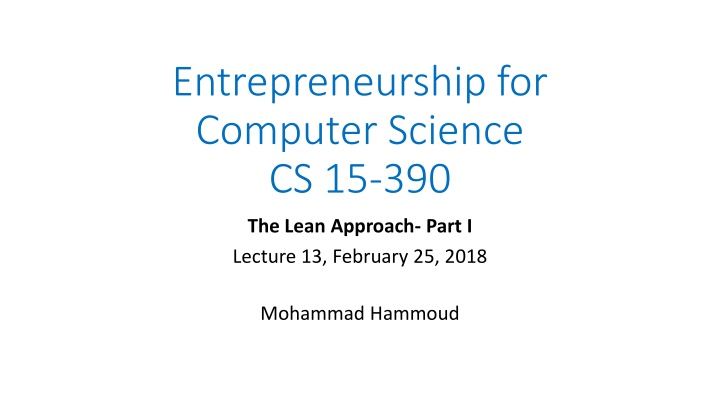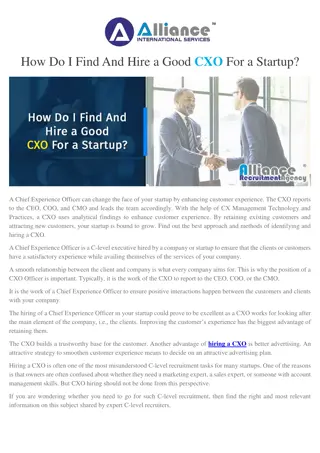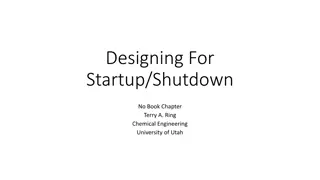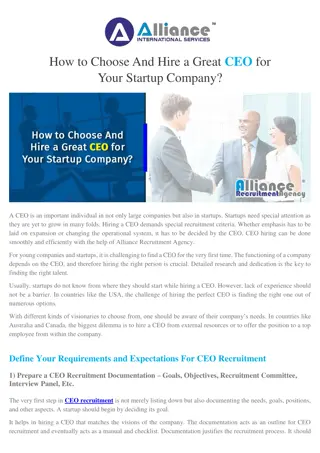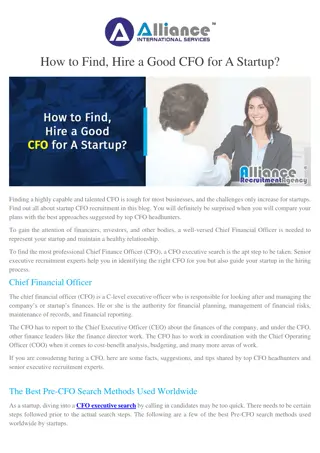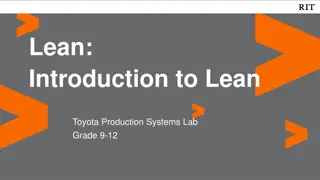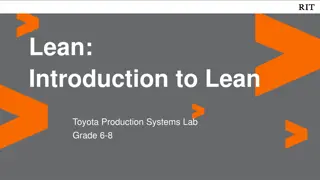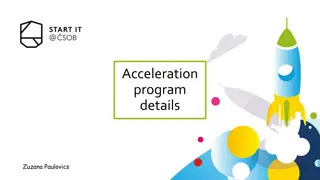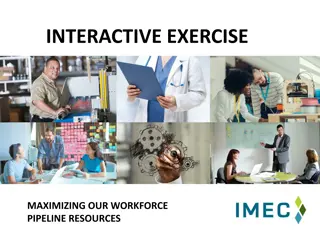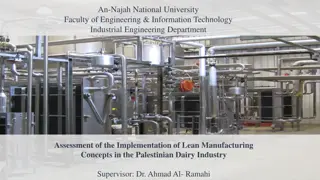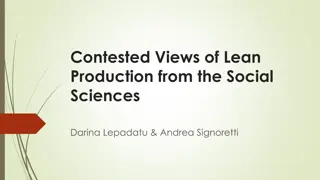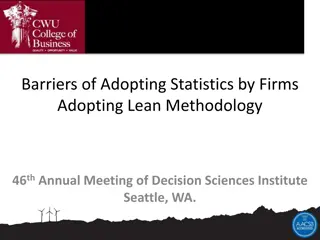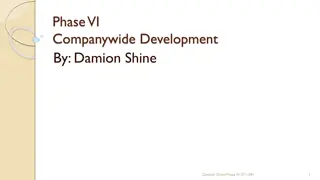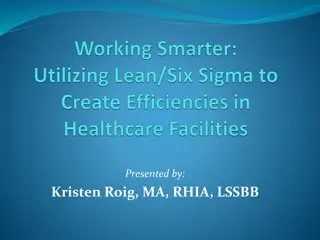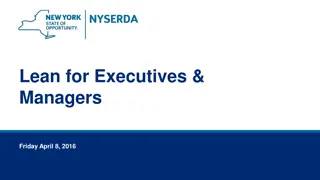The Lean Startup Approach for Product Development in CS 15-390
Explore the principles of lean thinking and the Build-Experiment-Learn feedback loop for successful value creation in product development. Understand the concept of Minimum Viable Product (MVP) through real-world examples like Dropbox, and learn how to align efforts with customers' needs effectively.
Download Presentation

Please find below an Image/Link to download the presentation.
The content on the website is provided AS IS for your information and personal use only. It may not be sold, licensed, or shared on other websites without obtaining consent from the author.If you encounter any issues during the download, it is possible that the publisher has removed the file from their server.
You are allowed to download the files provided on this website for personal or commercial use, subject to the condition that they are used lawfully. All files are the property of their respective owners.
The content on the website is provided AS IS for your information and personal use only. It may not be sold, licensed, or shared on other websites without obtaining consent from the author.
E N D
Presentation Transcript
Entrepreneurship for Computer Science CS 15-390 The Lean Approach- Part I Lecture 13, February 25, 2018 Mohammad Hammoud
Today Last Session: COCA Today s Session: Product Development: The Lean Startup Approach- Part I Announcements: CP1 is due on Feb 27 by midnight. Each team will be given 12 minutes to present its findings in class. Midterm is on March 13.
Value vs. Waste Question: Which of our efforts are value-creating and which are wasteful? Lean thinking defines value-creation as providing benefits to the customers; anything else is a waste! But, how can you know whether you are providing benefits (i.e., creating value) to your potential customers? Note: True startup productivity CANNOT be measured in terms of how much you are building every day, but rather in terms of systematically figuring out the right thing to build every day
Towards Value Creation Success is not about delivering a product; success is about delivering a product (or a feature of a product) that customers will use The way to do this is to continuously align your efforts with your customers real needs Note: This is not about asking your customers what they need because customers typically do not know what they need The Build-Experiment-Learn feedback loop allows you to discover your customers needs and methodically align with them
Build-Experiment-Learn Feedback Loop Idea Learn Build Data Product Experiment
Build-Experiment-Learn Feedback Loop Idea Learn Build The Build Phase Data Product Experiment
The Build Phase: MVP The build phase can be entered as quickly as possible with a Minimum Viable Product (MVP) An MVP ranges in complexity from extremely simple smoke tests (little more than an advertisement) to early prototypes Prototypes Smoke Tests A product with problems and missing features No product is built yet!
Example of MVP: Dropbox Dropbox is an easy-to-use file sharing (or synchronization) tool, which uses a push-based caching (or full replication) technique Push immediately to Dropbox service & all sharing devices
Example of MVP: Dropbox Dropbox requires integration with a variety of computer platforms and OSs: Windows, Macintosh, iPhone, Android, and so on It also necessitates deep understanding and expertise of distributed systems (caching, replication, consistency, reliability, availability, etc.) To avoid the risk of waking up after years of development with a product that nobody wanted, Drew Houston (founder & CEO of Dropbox) did something unexpectedly easy He made a video!
Example of MVP: Dropbox The video was a 3-minute demonstration of the technology as it is meant to work It was narrated by Drew himself (it was really banal!) It targeted early adopters, who do not need a perfect solution to get intrigued Drew recounted: It drove hundreds of thousands of people to the website. Our beta waiting list went from 5000 people to 75000 people literally overnight. It totally blew us away. Today, Dropbox is worth more than $10 billion Lesson: Think big but start small!
The Build Phase: MVP Deciding how complex an MVP cannot be done formulaically It requires judgment! When in doubt, simplify Avoid overbuilding and overpromising Any additional work beyond what needs to get you starting the loop might be a waste An MVP does not only speak to product design and technical questions, but also serves in testingfundamental business hypotheses Thus, it serves in providing a needed dose of reality
Build-Experiment-Learn Feedback Loop Idea Learn Build Data Product Experiment The Experimentation Phase
Dilemma: The Audacity of Zero It is often easier to raise money when you have: zero revenue zero customers zero traction than when you have a small amount of each! Zero invites imagination, but small numbers invite questions about whether large numbers will ever materialize This phenomenon (called the audacity of zero) creates a brutal incentive: Postpone getting any version of a product out until you are certain of success
Dilemma: The Audacity of Zero If you postpone experimenting with your MVP, some unfortunate results will emerge like: The amount of wasted work may increase Essential feedback will be missed The risk that your startup will build something nobody wants may increase But fund is important (a dilemma!), so what is the way out? Tradeoffs: Would you prefer to attract venture capital and potentially squander it? Or, would you prefer to attract venture capital and wisely use it? Use an MVP to experiment (initially, silently) with early adopters within your beachhead market Verify your concept via testing ALL its elements, starting with the riskiest ones Scale out on a solid slate fund will come naturally!
Leap-of-Faith Assumptions The riskiest elements of a startup s plan/concept (i.e., the parts on which everything depends) are called leap-of-faith assumptions E.g., What was the main leap-of-faith assumption of Dropbox? File synchronization is a problem Note: Most people do not know about a certain solution (or even a problem); but once they experience the solution, they cannot imagine how they ever lived without it!
Leap-of-Faith Assumptions The two most important leap-of-faith assumptions of any startup are the value hypothesis and the growth hypothesis The value hypothesis: It tests whether the product is really delivering value to customers after they start using it A testing metric: retention rate The growth hypothesis: It tests how new customers will discover the product A testing metric: referral rate or Net Promoter Score (NPS)
Example: Facebook In 2004, Facebook had 150,000 registered users with very little revenue Yet, that summer they raised their first $500,000 in venture capital Less than a year later, they raised an additional $12.7 million How Facebook was able to raise so much money when its actual usage was small?
Example: Facebook To answer this question, it suffices to look at Facebook s value and growth hypotheses: Validated value hypothesis: More than half of the users came back to the site every single day Validated growth hypothesis: Facebook launched on Feb 4, 2004, and by the end of that month, almost of Harvard s undergraduates were using it (without spending a dollar on marketing or advertising!)
Next Class Product development: the lean approach- Part II
